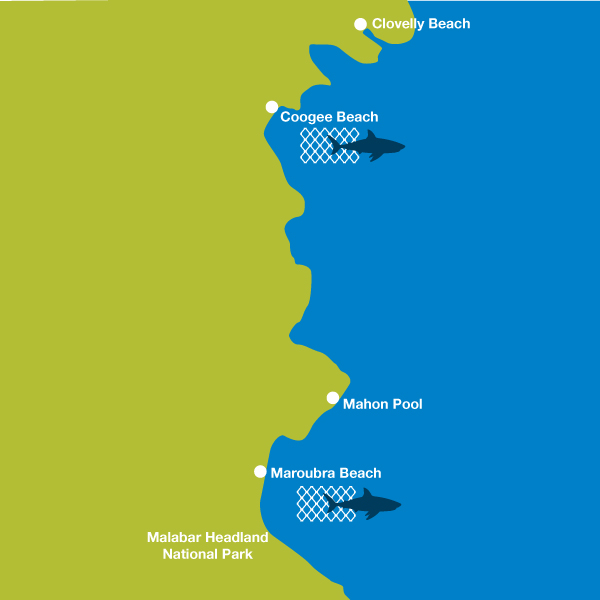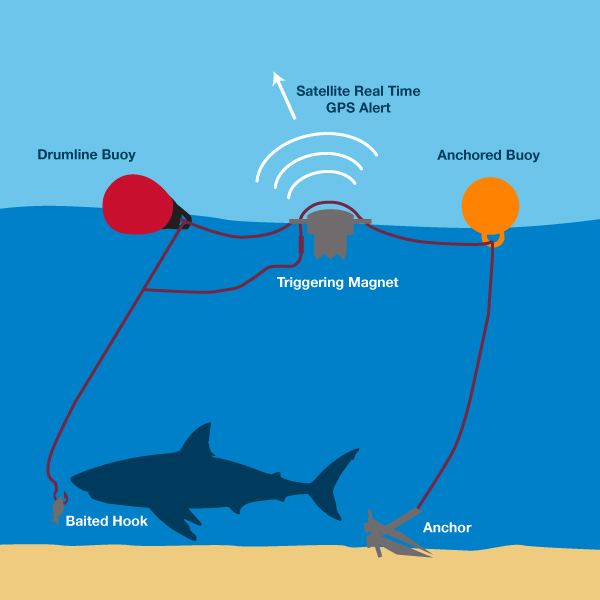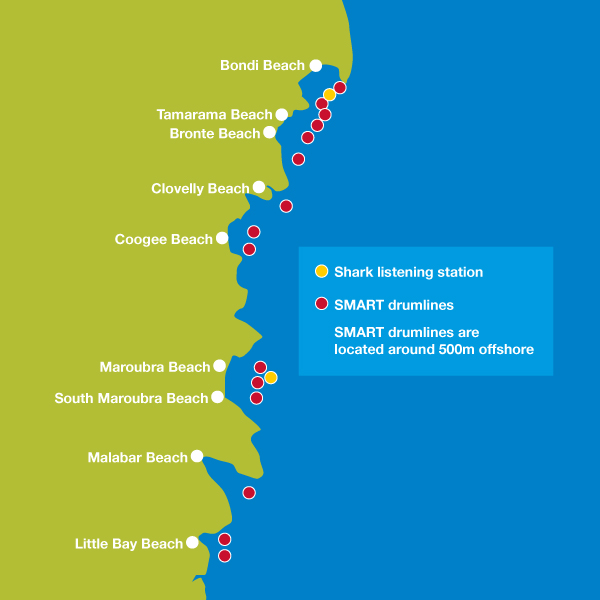Shark management
In summary
- Randwick Council is working with the NSW Department of Primary Industries (DPI) to trial SMART drumlines and shark listening stations along the Randwick City coastline.
- SMART stands for Shark Management Alert in Real Time.
- Previous research has shown that SMART drumlines are 15 times more efficient than nets for catching target sharks and catch significantly fewer non-target animals than nets.
- Nets will remain in place during the trial.
- Two shark listening stations have been deployed, one at Bondi Beach the other at Maroubra Beach.
- Randwick City Lifeguards fly a drone over Maroubra Beach to check for sharks.
Jump to section
What are shark nets?
The installation of mesh shark nets on Sydney beaches began in 1937 and were originally only located at beaches from Palm Beach to Cronulla. In 1949 beaches in Wollongong and Newcastle were added, with Central Coast beaches added in 1987. Today a total of 49 beaches covering approximately 200km of coastline are meshed.
The shark net program, currently run by the NSW Department of Primary Industries (NSW DPI), involves using specially designed nets located where the majority of people in NSW swim and surf. The nets are not designed to create a total barrier between bathers and sharks but to reduce the chances of a shark encounter.
Nets are deployed along beaches between September and April each year close to patrolled swimming areas. The nets do not stretch from one end of a beach to the other.
How do they work?
Shark nets in NSW are 150m long and 6 metres deep with a mesh size of 60cms. They sit approximately 4m below the surface of the water within 500m of the shore. They are fitted with whale alarms and dolphin ‘pingers’ to deter these animals from the netted area.
The shark mesh nets do not act as a complete barrier to sharks reaching beaches as they are not permanently set in the water, do not cover the whole length of the beach, and do not extend from the water surface to the seabed. In fact, approximately 40% of shark entanglements occur on the beach side of the nets, because sharks can swim over and around the nets.
Where they are?
Nets are installed at Coogee and Maroubra beaches from 1 September to 30 April, covering most of spring, summer and autumn.
Shark net by-catch
Unfortunately shark nets also catch non-targeted species, such as grey nurse shark and other threatened marine mammals. For this reason the shark net program is listed as a key threat to endangered and vulnerable species.
The shark net program adversely affects two shark species that are listed as vulnerable and/or endangered under the Fisheries Management Act 1994. The species are the Grey Nurse shark (endangered) and the Great White shark (vulnerable).
Species other than sharks are indiscriminately caught and often killed in the shark meshing program. These include Dugongs and Loggerhead turtles, which are listed as Endangered Species, and Green turtles, Leatherback turtles, Humpback Whale and Australian fur-seals (all vulnerable species).
Why Council is considering a change
As a result of the findings noted above, NSW DPI is of the opinion that the current shark net program in New South Wales adversely affects threatened species, populations or ecological communities and could cause species, populations or ecological communities that are not threatened to become threatened.
In 2021 funding for NSW Government’s Shark Management Program was nearly tripled to $21.4 million to support the expansion of effective, evidence-based shark management tools and technologies. This includes SMART drumlines, VR4G listening stations and shark-spotting drones.
That same year Council agreed to support additional shark mitigation measures including SMART drumlines and listening stations to catch, tag and release target sharks and monitor for the presence of tagged sharks in the area. In February this year, these tools were deployed along our coastline.
Shark nets will remain in use while these new technologies are trialled.
What are SMART drumlines?
SMART drumlines (which stands for Shark Management Alert in Real Time) and tagged shark listening stations are currently deployed along 21 locations half a kilometre off the Randwick City coastline by the DPI. A listening station has been deployed off Maroubra Beach.
Previous research has shown that SMART drumlines are 15 times more efficient than nets for catching target sharks, catch significantly fewer non-target animals than nets and result in a 99% survival rate of animals caught on the SMART drumlines compared to about 40% in nets.
The drumlines consist of a hook baited with one large sea mullet, which is attached to two buoys and a satellite-linked GPS communications unit that alerts contract boats when the bait has been taken. Within 30 minutes the contractor will pull up alongside the shark and spend the next 12-17 minutes tagging them with an acoustic tag, then will take them a further 1km offshore and release the shark. Non-target animals are given an identification tag and released in situ.

Where are they?
Drumlines are located in several places along the Eastern Suburbs beaches.

What are shark listening stations?
Shark listening stations are buoys that provide a real-time alert when a tagged shark swims within 500 metres. When a tagged shark is detected on any one of the listening stations, it sends information to the SharkSmart app, website and Twitter account with a date and time, where the shark was previously detected and where it was originally tagged, so people can see the movements of sharks in the area.
Drone surveillance
Randwick City Council lifeguards fly drones at Maroubra throughout the year as part of the shark management program.
Get the app
Download the SharkSmart app today
For iOS visit the iTunes store, or for Android visit Google Play.
Head here to read more about Council's approach to shark management
